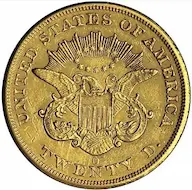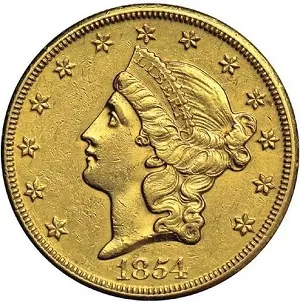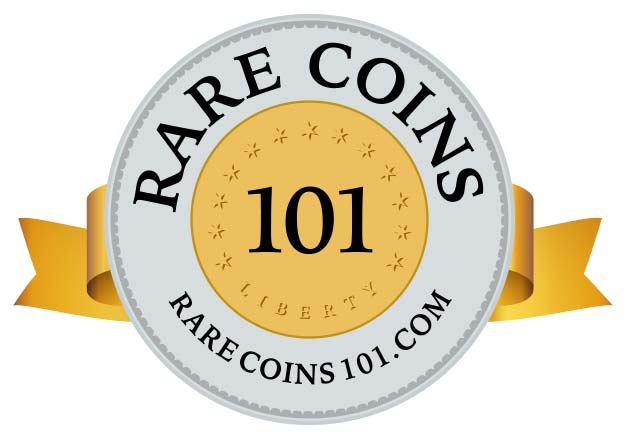1854-O Coronet $20 Double Eagle
The 1854-O is one of the most legendary $20 double eagles ever issued by the United States. It is the rarest New Orleans twenty, rivaled only by the 1856-O.(1)
Double eagle production at the southern mint started out with a bang in 1850 when 141,000 pieces of the new Coronet design rolled off the coining presses, followed by 315,000 and 190,000 in 1851 and 1852, respectfully. In 1853, production dropped to 71,000, but in 1854, the bottom fell out when mintage plummeted to just 3,250.(2)
Double eagle output remained small every year in the Crescent City until the outbreak of the Civil War in 1861, when all federal coinage came to a full stop following the mint takeover by the Confederacy.(3)
Historians have identified several causes for the sharp drop in double eagles. First of all, the building was chronically plagued by foundation issues, requiring extensive repairs that interfered with production. There were also machinery problems which led to delays.
However, it was the opening of the San Francisco Mint in 1854 that was the main “culprit” explaining the drastic plunge in New Orleans double eagles. Prior to the opening of the mint on the west coast, New Orleans was the closest coining facility to the California gold mining district.
The commencement of coinage operations at San Francisco eliminated the need for transporting gold thousands of miles to New Orleans and Philadelphia, greatly limiting the supply of the precious metal at the southern mint, accounting for the low mintage of double eagles starting in 1854.
The small number of 1854-O double eagles was released into circulation and travelled extensively throughout the South and west of the Mississippi River.(4) There was little numismatic interest in the issue during its years of service, permitting normal attrition to claim nearly 99% of the original mintage.(5)
Fast forward to 1893, when Augustus Heaton opened a new genre in coin collecting with the publication of A Treatise on the Coinage of the United States Branch Mints. Numismatists began to pay more attention to certain mintmarks and their inherent rarity. Heaton discovered from old U.S. Mint records there were a small number of 1854-O double eagles once upon a time, but admitted he had never seen one of the coins himself.(6)
In fact, none of the great collections of the 1890’s contained an example of the 1854-O double eagle. By the 1920’s, just two specimens had surfaced.
The Gold Recall of 1933 forbade average citizens from accumulating the precious metal, but exempted "gold coins having recognized special value to collectors of rare and unusual coins". Savvy investors recognized this as an avenue to legally own gold. It wasn’t long before 1854-O double eagles and other rare gold coins were flushed out of their hiding places to meet the new demand.(7)
In December 1933, the 1854-O double eagle made its first auction appearance. Throughout the 1930’s and 1940’s, the coin earned an exalted reputation as it increasingly crossed the auction block.(8)
Today, PCGS estimates only 40 examples of the 1854-O Coronet double eagle are all that remain.(9)
In their expert work An Insider's Guide to Collecting Type I Double Eagles 1850-1866, writers Douglas Winter and Adam Crum commented: "The serious collector will not have many opportunities to purchase an 1854-O double eagle. This is an issue that is so rare and desirable that you cannot really 'overpay' for it."(10)
To say it is impossible to overpay for anything is debatable, but as one of the most revered dates in United States numismatics, the 1854-O double eagle has tremendous long-term potential, with little downside risk.
| Estimated survivors in all grades: 8.7 ?
The survivor estimate from PCGS represents an average of one or more experts' opinions as to how many examples survive of a particular coin in all grades. Survival estimates include coins that are raw, certified by PCGS, and certified by other grading services. Learn more at PCGS. |
| PCGS Rarity Scale: 40 ?
The 'PCGS CoinFacts Rarity Scale' assesses the relative rarity of all U.S. coins, based on estimated surviving examples. The scale runs from 1.0 to 10.0. The higher the number, the rarer the coin.
Learn more at PCGS. |
| Search for the 1854-O Coronet $20 Double Eagle on eBay** |
Preview of eBay selection (one of the greatest coins in U.S. numismatics -- not often does it appear here):
 |
 |
| Trendline Avg = 31.81 | BEST |
 |
 |
| Trendline Avg = 31.81 | BEST |
Historic Value Trend Charts:
| Last updated 10-9-24 | Return to Key Date Coin List | |
| Compare to Common Date Coin of Same Type | ||
|
|
||
| Download Charts to Your Computer | ||
Sources
1. Heritage Auctions. 1854-O $20. Jan 2011 Auction.
2. Yeoman, R.S. and Garrett, Jeff, et al. A Guide Book of United States Coins, 75th ed. Pelham, AL: Whitman Publishing, 2021.
3. Heritage Auctions. 1854-O $20. Jan 2011 Auction.
4. Stack's Bowers Galleries. 1854-O Liberty Head Double Eagle. Nov 2019 Auction.
5. PCGS. 1854-O $20 (Regular Strike).
6. Heritage Auctions. 1854-O $20. Jan 2011 Auction.
7. Heritage Auctions. 1854-O $20. Jan 2014 Auction.
8. Heritage Auctions. 1854-O $20. Jan 2011 Auction.
9. PCGS. 1854-O $20 (Regular Strike).
10. Heritage Auctions. 1854-O $20. Aug 2006 Auction.
**Many very fine coin dealers sell on eBay. At any point in time, there may be over one million search results for United States coins. This includes quite a few of the recommendations on our Key Date Coin List.
If you’re thinking about purchasing a rare coin, eBay is certainly worth a look. For your convenience, the links from this site to eBay are coded to bring up only coins certified by PCGS and NGC.
As is always, always the case, never buy a valuable coin from a seller whose trustworthiness cannot be verified. Learn more about this at our chapter Best Places to Buy Coins, which also has a section on doing business on eBay.
In the interest of full disclosure, Rare Coins 101 receives a small commission anytime someone connects to eBay from this site and purchases something.
Coin images by Stack's Bowers Galleries.


